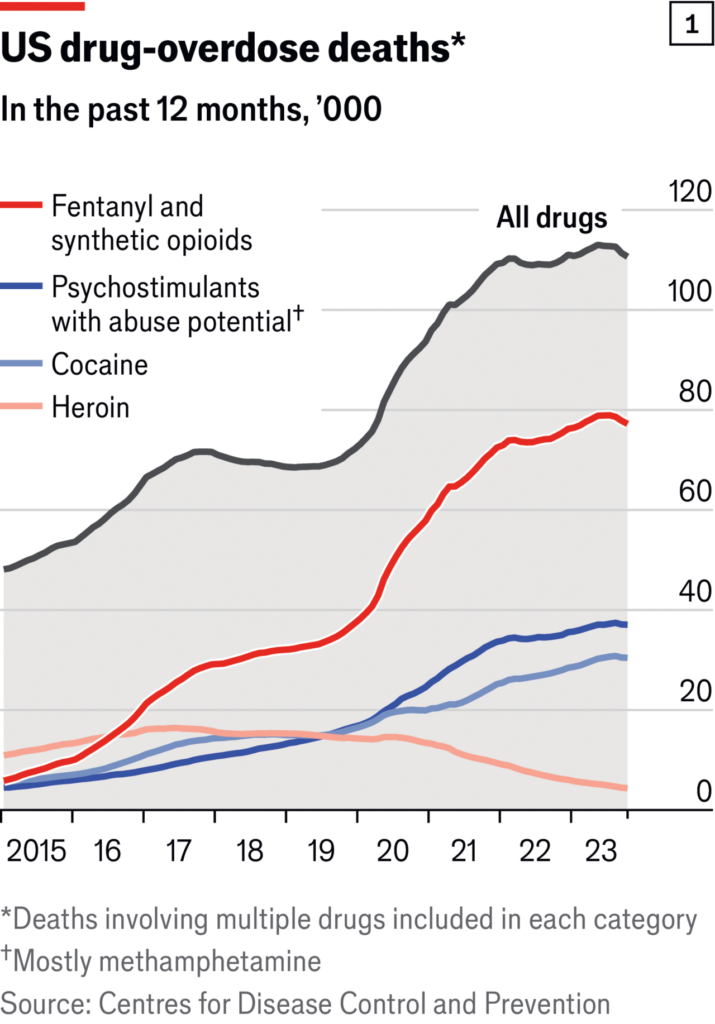China may help the US fight the deadly fentanyl epidemic to get a seat at the trade negotiation table
WSJ reports that China is eyeing potential assistance in cracking down on the fentanyl trade in North America as a possible pretext for starting China-U.S. trade negotiations. Fentanyl overdoses take the lives of dozens of thousands of people in the U.S. and Canada annually. China is a key player in the North American fentanyl market.
According to unnamed sources cited by The Wall Street Journal, China may propose cooperation on the fentanyl crisis as an “off-ramp from hostilities” to foster dialogue with the Trum administration. Potentially, China has a resource to tackle the North American fentanyl problem as its role in this crisis and market is essential. Reportedly, Chinese chemical companies export fentanyl precursors and provide consultations to Americans wishing to synthesize the drug on online forums.
China may hope for dialogue as the role of fentanyl was explicitly cited by Donald Trump when he motivated imposing the harshest tariffs on China, the only country not granted a 90-day tariff pause. The dialogue between China and the U.S. is not impossible, as recently Trump himself said, “it’s a natural thing to ask,” referring to asking China to assist in solving the conflict between Russia and Ukraine.
Fentanyl crisis statistics
Terms like “fentanyl crisis” and “fentanyl epidemic” are no exaggeration. The word “tragedy” also fits.
Fentanyl is a synthetic opioid used medically as an anesthetic but far more potent than heroin or morphine. In the 2010s, recreational use of fentanyl exploded in North America, resulting in hundreds of overdose deaths daily. At the peak in 2022, the fatal overdoses on synthetic opioids (mostly fentanyl) reached nearly 80,000 in the U.S. alone.
In Canada, with its 5x lower population, the numbers are not as high as in the U.S. For instance, 2023 was marked with around 6,000 deaths related to fentanyl. However, if we look at the deaths per 100,000 of the population, we’ll see that Canada is close to the U.S.

Most of the victims of overdose are men under 45 years old, but the number of elders among fentanyl casualties is on the rise. The crisis affected both men and women of all ages, including preschoolers.
These numbers may seem too huge to realize the scale of the tragedy. To get a more vivid and striking idea of this epidemic’s deadliness, we may think that at the peak, it was killing one person per hour in Canada and one person every seven minutes in the U.S.
Although after 2022 both the U.S. and Canada saw a drop in fentanyl deadly overdoses, the epidemic scale is still damning. Council on Foreign Relations notes that the 2022 fentanyl death count is 10x bigger than the total casualties of the U.S. army in the Iraq and Afghanistan wars combined. Comparisons to wars don’t look misplaced. The death toll in the fentanyl crisis is in line with the number of deaths in the most dismaying military conflicts of the 2020s: in Sudan, Gaza, Yemen, and Ukraine.
Somehow, North America reached the point at which it has war-scale casualties, while it doesn’t participate in a war. Except for the U.S. trade war. Two countries subjected to the harshest tariffs are the key players in the fentanyl trade in America: China and Mexico. Another country that faced high tariffs is Canada. Fentanyl from Canadian Valerian Labs was a part of the problem too.
Fentanyl trade: China, Mexico, and cryptocurrency
In 2022, the Drug Enforcement Agency called China the prime source of fentanyl killing Americans. The drug is sent to North America from China by mail or through Mexico. Two years later, a Congressional committee claimed that China is subsidizing the production of fentanyl precursors that then turn into illicit drugs in North America. The report reads:
“The PRC (People’s Republic of China) scheduled all fentanyl analogues as controlled substances in 2019, meaning that it currently subsidizes the export of drugs that are illegal under both U.S. and PRC law. [Some of the substances] have no known legal use worldwide.”
Chinese authorities deny responsibility for the crisis and claim to have cooperated with U.S. enforcement efforts to suppress trafficking.
Meanwhile, cryptocurrency is playing a dual role. A February 2025 Chainalysis report highlighted how digital assets both facilitate and expose the fentanyl trade. On darknet markets, fentanyl and its precursors are often sold for Bitcoin or Monero.
Chainalysis noted that some buyers and sellers don’t anonymize their activity, allowing analysts to map out trafficking networks. Cryptocurrency enables remote drug purchases and money laundering but also provides transparency that cash doesn’t.
“While the cartel may have benefitted from speed, low transaction fees, and cross-border efficiency, their reliance on the blockchain has allowed investigators to trace these transactions more easily than would have been possible with traditional cash-based money laundering. Furthermore, it allows even greater disruptive potential, because issuers and centralized services typically have the ability to freeze assets when necessary.”
That’s an unobvious way in which crypto facilitates drug trafficking and helps to disrupt the illicit substance markets at the same time.
Conclusion
Whether China is truly willing or able to dismantle its transcontinental fentanyl supply chain remains unclear. Still, it’s a powerful bargaining chip as trade talks with the Trump administration loom. In 2019, Assistant U.S. Attorney Matt Cronin put it bluntly: “It is a fact that if the People’s Republic of China wanted to shut down the synthetic opioid industry, they could do so in a day.”

